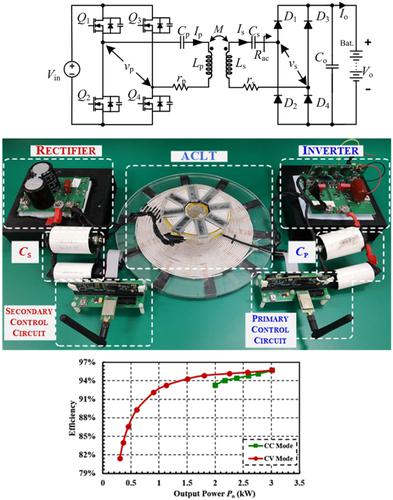当前位置:
X-MOL 学术
›
Int. J. Circ. Theory Appl.
›
论文详情
Our official English website, www.x-mol.net, welcomes your
feedback! (Note: you will need to create a separate account there.)
Design and optimization of 3‐kW inductive power transfer charging system with compact asymmetric loosely coupled transformer for special applications
International Journal of Circuit Theory and Applications ( IF 1.8 ) Pub Date : 2020-12-01 , DOI: 10.1002/cta.2909 Hongbo Ma 1 , Xiaobin Li 1 , Bin Zhang 1 , Junhong Yi 1 , Xiaoqiang Wang 1 , Jianping Xu 1
International Journal of Circuit Theory and Applications ( IF 1.8 ) Pub Date : 2020-12-01 , DOI: 10.1002/cta.2909 Hongbo Ma 1 , Xiaobin Li 1 , Bin Zhang 1 , Junhong Yi 1 , Xiaoqiang Wang 1 , Jianping Xu 1
Affiliation

|
Inductive power transfer (IPT) technology has become popular in wireless charging applications. Compared with the traditional 3‐kW wireless charging application, the diameter for the primary coil and the secondary coil in this special design are required to be smaller than 260 and 110 mm, respectively. In order to achieve this target, an approach to design and optimize the loosely coupled transformer (LCT) is proposed to match the strict geometry limitation, while achieving the high conversion efficiency. Different from the traditional design method, the low resonant current and voltage stress are considered as the input of the design flowchart, especially the LCT. Thus, the overall conversion efficiency can be improved. Based on series–series (S–S) compensation topology, the parameter range of the LCT is determined by analyzing transformer‐based equivalent model. To achieve the desired coil size, an asymmetric LCT with single‐layer primary coil and three‐layer secondary coil is designed and optimized by the proposed approach. Furthermore, the closed‐loop controller with narrow frequency variation range is design to realize constant current (CC) charge and constant voltage (CV) charge. A 3‐kW IPT charging prototype is built to demonstrate the validity of the proposed method. Experimental results show that the peak efficiency from input to battery load is 95.69% at 3‐kW output power in the transition point from CC mode to CV mode.
中文翻译:

具有紧凑型不对称松耦合变压器的3kW感应式电力传输充电系统的设计和优化,用于特殊应用
感应功率传输(IPT)技术已在无线充电应用中变得流行。与传统的3kW无线充电应用相比,在这种特殊设计中,初级线圈和次级线圈的直径分别必须小于260和110 mm。为了实现此目标,提出了一种设计和优化松耦合变压器(LCT)的方法,以匹配严格的几何限制,同时实现高转换效率。与传统的设计方法不同,低谐振电流和低电压应力被视为设计流程图(尤其是LCT)的输入。因此,可以提高整体转换效率。基于串联(S–S)补偿拓扑,LCT的参数范围是通过分析基于变压器的等效模型确定的。为了达到所需的线圈尺寸,通过所提出的方法设计并优化了具有单层初级线圈和三层次级线圈的不对称LCT。此外,设计了具有窄频率变化范围的闭环控制器,以实现恒定电流(CC)充电和恒定电压(CV)充电。建立了一个3 kW IPT充电原型,以证明所提出方法的有效性。实验结果表明,在从CC模式到CV模式的过渡点,在3kW输出功率下,从输入到电池负载的峰值效率为95.69%。此外,设计了具有窄频率变化范围的闭环控制器,以实现恒定电流(CC)充电和恒定电压(CV)充电。建立了一个3 kW IPT充电原型,以证明所提出方法的有效性。实验结果表明,在从CC模式到CV模式的过渡点,在3kW输出功率下,从输入到电池负载的峰值效率为95.69%。此外,设计了具有窄频率变化范围的闭环控制器,以实现恒定电流(CC)充电和恒定电压(CV)充电。建立了一个3 kW IPT充电原型,以证明所提出方法的有效性。实验结果表明,在从CC模式到CV模式的过渡点,在3kW输出功率下,从输入到电池负载的峰值效率为95.69%。
更新日期:2020-12-01
中文翻译:

具有紧凑型不对称松耦合变压器的3kW感应式电力传输充电系统的设计和优化,用于特殊应用
感应功率传输(IPT)技术已在无线充电应用中变得流行。与传统的3kW无线充电应用相比,在这种特殊设计中,初级线圈和次级线圈的直径分别必须小于260和110 mm。为了实现此目标,提出了一种设计和优化松耦合变压器(LCT)的方法,以匹配严格的几何限制,同时实现高转换效率。与传统的设计方法不同,低谐振电流和低电压应力被视为设计流程图(尤其是LCT)的输入。因此,可以提高整体转换效率。基于串联(S–S)补偿拓扑,LCT的参数范围是通过分析基于变压器的等效模型确定的。为了达到所需的线圈尺寸,通过所提出的方法设计并优化了具有单层初级线圈和三层次级线圈的不对称LCT。此外,设计了具有窄频率变化范围的闭环控制器,以实现恒定电流(CC)充电和恒定电压(CV)充电。建立了一个3 kW IPT充电原型,以证明所提出方法的有效性。实验结果表明,在从CC模式到CV模式的过渡点,在3kW输出功率下,从输入到电池负载的峰值效率为95.69%。此外,设计了具有窄频率变化范围的闭环控制器,以实现恒定电流(CC)充电和恒定电压(CV)充电。建立了一个3 kW IPT充电原型,以证明所提出方法的有效性。实验结果表明,在从CC模式到CV模式的过渡点,在3kW输出功率下,从输入到电池负载的峰值效率为95.69%。此外,设计了具有窄频率变化范围的闭环控制器,以实现恒定电流(CC)充电和恒定电压(CV)充电。建立了一个3 kW IPT充电原型,以证明所提出方法的有效性。实验结果表明,在从CC模式到CV模式的过渡点,在3kW输出功率下,从输入到电池负载的峰值效率为95.69%。










































 京公网安备 11010802027423号
京公网安备 11010802027423号